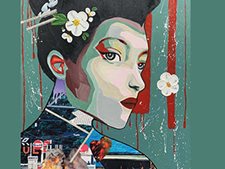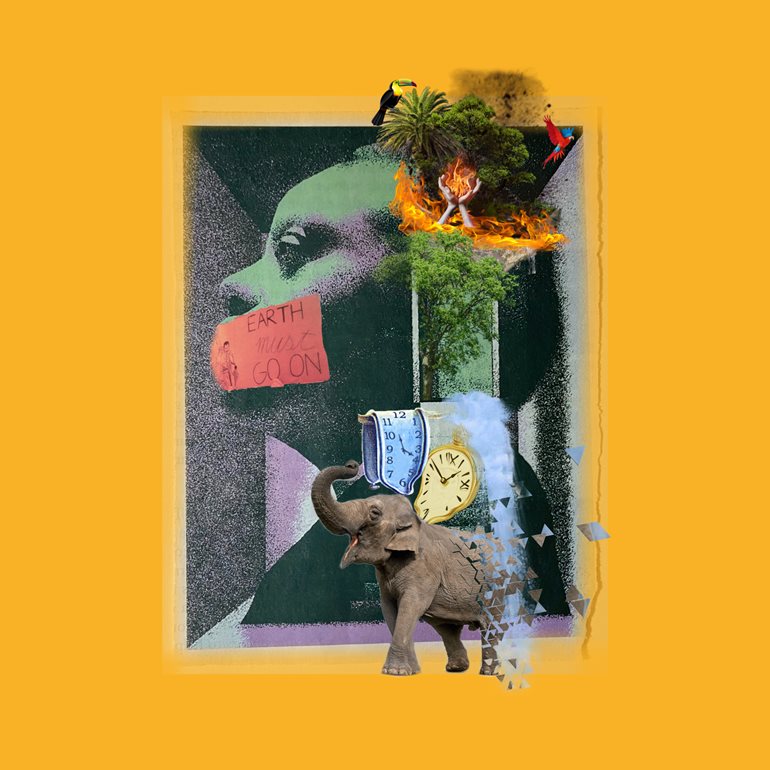Like postal carriers who aren’t deterred by rain nor heat nor gloom of night to complete their rounds, the editors of Clamor didn’t let the virtual learning environment, a global pandemic, ongoing civic unrest and environmental destruction stop them from publishing the 2021 edition of the University of Washington Bothell’s literary and arts journal.

In fact, since the publication typically represents the current zeitgeist, people will likely — pardon the pun — clamor for a physical copy like never before as this edition will be a time capsule of sorts.
The 2020 edition was well underway when the lockdown was announced last spring, and editors, with the guidance of Anida Yoeu Ali, who is senior artist-in-residence in the School of Interdisciplinary Arts & Sciences, published the journal remotely.
This year’s journal will be released later this week. Clamor staff have set aside Wednesday, June 9, from 11 a.m. to 6 p.m. for a physically distanced distribution event in front of the Activities & Recreation Center at 18220 Campus Way NE. Wear a mask and walk up or drive by to pick up your copy.
There also will be a virtual launch party on Friday, June 11, from 11 am. to 1 pm. It will feature readings, performances and screenings of work, along with games and opportunities to connect with artists. Register to receive the Zoom link for the event.
Understanding the process
Published each spring, Clamor begins in a class in the School of Interdisciplinary Arts & Sciences the previous autumn quarter. Mentored by a faculty member — this year Dr. Amaranth Borsuk, associate professor — along with Dr. Ching-In Chen, assistant professor, students solicit submissions through classroom visits, events and social media. The students serve as the editors and initially submit their own work so they can practice the curation process and build empathy toward future submitters.
Sanika Nalgirkar, an M.F.A. candidate in Creative Writing & Poetics, submitted work last year that was not accepted. “As an editor this year, I have a better understanding of what it takes to get published,” she said. “There are enlivening discussions and diverse points of view, and it can take a lot of convincing and advocating before one is approved.
“Being part of this process,” she said, “has shown me that my future will include some sort of art curation. That’s exciting.”
So is the fact that one of Nalgirkar’s works was accepted to be included in the new edition.
In winter quarter, the editors begin evaluating submissions. Because art is subjective, they thoughtfully analyze the pieces, giving each a fair amount of attention and conversation. By spring quarter, the students make their final selections and begin the publishing process.
“The course outline rarely fluctuates,” said Borsuk. “What makes Clamor fresh each year is the diverse group of editors we see with each edition. We encourage people to resubmit if their work isn’t chosen, and even repeat editors looking at a repeat submission may have a different reaction the second time based on perspectives of new editors.”
How do you talk about art?
Although art is subjective, given that readers have experienced the same circumstances this past year as the editors, Clamor staff decided to share some of the criteria they used to evaluate submissions as they curated the 2021 edition. They hope it will provide insight into their choices largely representing these “quarantimes” we are in together, while acknowledging that reactions to the same circumstances vastly differ.
Criteria for 2021 Clamor
- Does this piece draw you in, intrigue or interest you?
- Do you find the work thought-provoking?
- Is there something about it that resonates with you or that you think would resonate with our audience?
- Does it make you feel something, stir an emotion?
- Does it do something novel — something you haven’t seen before?
- Does it show a perspective different from your own — a perspective you value?
- Does it use vivid imagery and language that help you visualize what you are reading?
- Does it make you feel like you are in it?
- Does it hold your attention and/or reward deeper examination?
- Are you still thinking about it later?
- Does it have multiple layers of meaning?
- Does it have a message (can we garner different meanings as well)?
- Does it stimulate dialogue?
To further demonstrate the curation process, Nalgirkar and fellow editor Jennifer Dormier each chose a work of art in the new edition and talked through the group’s decision-making process.
In her review of “Earth Must Go On,” a mixed media piece by Kong Solika Tang, a student majoring in Law, Economics & Public Policy, Dormier said:

“The team was enthralled by this piece, and it drew me in. It has multiple layers of meaning, and I don’t know that we ever discovered them all,” she said. “The forest, the toucan and the fire reminded us of the Amazon burning, and the hands add a human element to it. The melting clocks: time is running out. The elephant breaking into fragments — is that what will happen to Earth if we don’t do something about climate change? The parrot fleeing the environment that sustains its life — where is it going to go? Does it know something we don’t? And why is the person being muzzled for saying, ‘Earth must go on?’
“There’s an interesting story and narrative in this piece,” Dormier said. “I still think about it.”
Editor Nalgirkar “immediately loved “Tired,” an essay by Nina Jouval, a senior in Media & Communication Studies. In her evaluation, Nalgirkar said:
“The entire piece resonated with me, beginning with the title. Who isn’t tired right now? The imagery is vivid, and I could clearly see it in my mind,” she said. “It has a dream-like quality, even though the main character is awake. Or waking up, maybe from the pandemic. Reading this, I felt I was more than a reader. It’s like I’m in the story, since it’s kind of the story of my life right now.
“I’m that girl, waking up to an uproarious noise.”
Tired
By Nina Jouval
I woke up in an empty room. To a noise so uproarious that it rattled my skull. I can’t move. My room looks lonely with nothing but a bed. Is this my room? The worries of yesterday are weighing me down. All I can do is think about how tired I am and how wonderful it sounds to doze back off to dreamland. But the noise grows stronger and causes the walls to buzz. I try to drown out the noise by pressing my pillow hard against my ears, but the commotion persists. Then suddenly I start floating out of bed. And once my feet hit the floor the noise abruptly ceases. My ears say thank you. As I walk toward the door, I don’t seem to get any closer. I walk faster, and faster, and start to run, but somehow, I’m not going anywhere. I look up to the ceiling and see a black sky with speckled stars. I look out the window and see a bright blue sky with clouds fluffy enough to eat at a carnival. The deep dark sky suddenly begins to spin like a planetarium. Faster and faster until my mind starts doing cartwheels and I fall on my knees. I stay with my eyes closed to wait for the spinning to stop, but it doesn’t. Seems like hours have gone by. I slowly raise my heavy eyelids and the twirling stops. When I look around, I’m no longer in my room. I’m in a dense jungle. The soft, mossy ground feels comforting on my bare feet. The countless plants and trees loom above me with no sky in sight. Various jungle animals squeak, squawk, and purr… Purr? I leap around, ready to be attacked by a tiger, but it’s a charming little black cat.
She hops up on my shoulder and whispers, “What are you doing in a place like this? You don’t belong here.” I know. We start walking aimlessly and come across a bridge, but I can’t see where it ends. I start on the bridge with the cat trotting beside me. First, I see a giant multicolored butterfly the size of a grand piano. It blocks the way with its wings and stares at me with its mesmerizing motif.
I say, “Do you mind moving out of my way? I’m trying to get somewhere.”
The butterfly says, “Well where are you trying to go?”
I pause and reply, “I don’t know. Home?”
The butterfly’s wings start to shift and change. “You seem uncertain.” Before I can respond, the cat lunges at it. The butterfly lifts off with its colossal wings. I continue on the bridge and see a spotted blue boa constrictor. It slides up my leg and wraps around me loosely.
“What are you doing?” I say.
The snake replies, hissing, “You’re missing something. There’s a hole somewhere.” It tightens ever so slightly, and I panic. I squirm to get the snake off, but it keeps getting tighter. My heart races and I can’t breathe. I wish it to be gone over and over in my head and it finally loosens and disappears into the jungle. The cat hisses as the snake crawls away. I start to wonder how much longer this bridge is going to be. Why won’t it end? I see what looks like a white door up ahead and I run toward it. But then I see a figure in front of it. It’s a big, dark owl. I stop, and uncontrollably, I begin to cry. The tears are an inky black, running down my silk pajamas. I look for the black cat and she’s gone. I cry harder. The owl says nothing. It embraces me with its massive wings, encasing my entire body and I go limp. At this point, it feels like a year has gone by, but at the same time, it’s felt like no time at all. I finally let out a powerfully strident scream and I reach the white door, turning the knob and finding myself outside my room. My mom asks me what I have been doing lately.
“I’m tired,” I say.
Creating space for art
The 2021 Clamor predominantly represents work by UW Bothell students. Submissions align with past years — 58% creative writing, 36% visual art, 4% media and 2% collaborations — highlighting the fact that no matter what, art must go on.
Dormier, a senior in Media & Communication Studies whose work was accepted in 2020 and 2021, said her biggest takeaway from working on Clamor is “how valuable it is to create space for art and the community sharing of art.
“Clamor allows us to amplify people’s voices and our different perspectives,” she said. “There is a vulnerability to putting your work out there, and it can be nerve-wracking. But it’s important to contribute who you are, in art and in life.”



